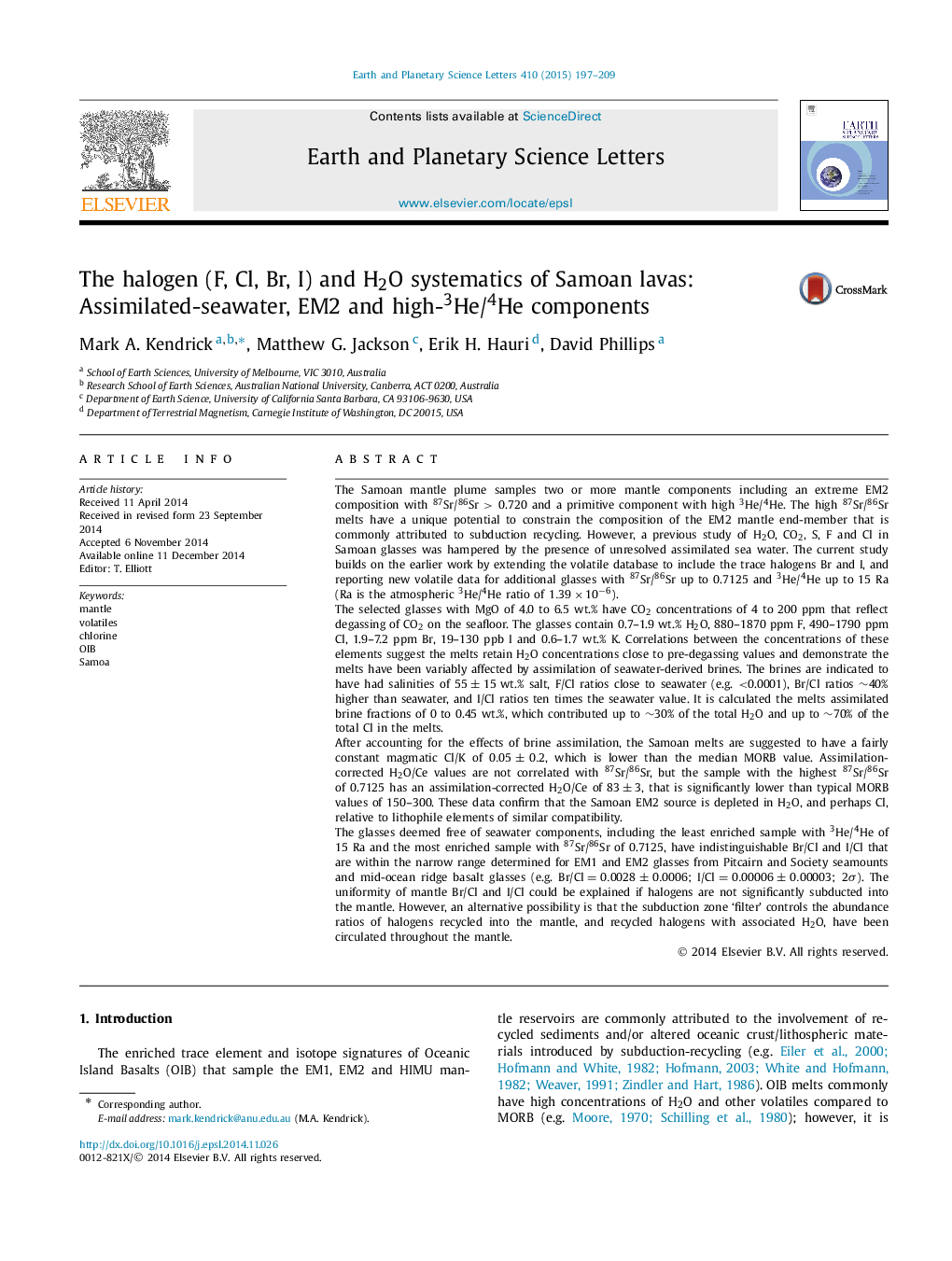| کد مقاله | کد نشریه | سال انتشار | مقاله انگلیسی | نسخه تمام متن |
|---|---|---|---|---|
| 6428470 | 1634746 | 2015 | 13 صفحه PDF | دانلود رایگان |

- Volatile systematics of submarine glasses from Samoan volcanoes are investigated.
- Brine assimilation (<0.45 wt.%) introduced <30% of H2O and <70% of total Cl.
- H2O and halogens were not lost during subsequent open system degassing.
- The EM2 source is depleted in Cl and H2O, relative to Ce and K in median MORB mantle.
- Samoan lavas have Br/Cl (â¼0.0028) and I/Cl (â¼0.00006) similar to MORB.
The Samoan mantle plume samples two or more mantle components including an extreme EM2 composition with 87Sr/86Sr > 0.720 and a primitive component with high 3He/4He. The high 87Sr/86Sr melts have a unique potential to constrain the composition of the EM2 mantle end-member that is commonly attributed to subduction recycling. However, a previous study of H2O, CO2, S, F and Cl in Samoan glasses was hampered by the presence of unresolved assimilated sea water. The current study builds on the earlier work by extending the volatile database to include the trace halogens Br and I, and reporting new volatile data for additional glasses with 87Sr/86Sr up to 0.7125 and 3He/4He up to 15 Ra (Ra is the atmospheric 3He/4He ratio of 1.39Ã10â6).The selected glasses with MgO of 4.0 to 6.5 wt.% have CO2 concentrations of 4 to 200 ppm that reflect degassing of CO2 on the seafloor. The glasses contain 0.7-1.9 wt.% H2O, 880-1870 ppm F, 490-1790 ppm Cl, 1.9-7.2 ppm Br, 19-130 ppb I and 0.6-1.7 wt.% K. Correlations between the concentrations of these elements suggest the melts retain H2O concentrations close to pre-degassing values and demonstrate the melts have been variably affected by assimilation of seawater-derived brines. The brines are indicated to have had salinities of 55±15 wt.% salt, F/Cl ratios close to seawater (e.g. <0.0001), Br/Cl ratios â¼40% higher than seawater, and I/Cl ratios ten times the seawater value. It is calculated the melts assimilated brine fractions of 0 to 0.45 wt.%, which contributed up to â¼30% of the total H2O and up to â¼70% of the total Cl in the melts.After accounting for the effects of brine assimilation, the Samoan melts are suggested to have a fairly constant magmatic Cl/K of 0.05±0.2, which is lower than the median MORB value. Assimilation-corrected H2O/Ce values are not correlated with 87Sr/86Sr, but the sample with the highest 87Sr/86Sr of 0.7125 has an assimilation-corrected H2O/Ce of 83±3, that is significantly lower than typical MORB values of 150-300. These data confirm that the Samoan EM2 source is depleted in H2O, and perhaps Cl, relative to lithophile elements of similar compatibility.The glasses deemed free of seawater components, including the least enriched sample with 3He/4He of 15 Ra and the most enriched sample with 87Sr/86Sr of 0.7125, have indistinguishable Br/Cl and I/Cl that are within the narrow range determined for EM1 and EM2 glasses from Pitcairn and Society seamounts and mid-ocean ridge basalt glasses (e.g. Br/Cl=0.0028±0.0006; I/Cl=0.00006±0.00003; 2Ï). The uniformity of mantle Br/Cl and I/Cl could be explained if halogens are not significantly subducted into the mantle. However, an alternative possibility is that the subduction zone 'filter' controls the abundance ratios of halogens recycled into the mantle, and recycled halogens with associated H2O, have been circulated throughout the mantle.
Journal: Earth and Planetary Science Letters - Volume 410, 15 January 2015, Pages 197-209